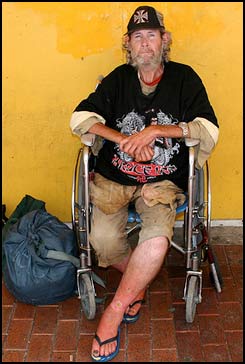
The fictional character of Dracula was inspired by the real Prince Vlad of Romania, sarcastically described here by Robert Davenport in his Roots of the Rich and Famous:
Realizing that the plight of the homeless was an important problem in his country, he had all of the homeless people invited to a huge feast in a specially prepared building. They were then fed until they could barely move, at which point Dracula had the doors closed and the building burned down, thus ‘eliminating’ the problem.
We have come a long way since then, and some locales have made more progress than others. Last week, House the Homeless blog looked at the advantages of housing the homeless, especially the small percentage who place a disproportionate strain on the budgets of jails and courts.
And fire departments. Last year in Albuquerque, for instance, nearly 80% of one fire station’s calls (3,000 of them) rendered aid to homeless people with substance addictions. Is it really in a city’s best interest to employ fire trucks for anything but fires?
In the same city, the “Heading Home” initiative was planned to create publicly funded housing for the 75 most vulnerable homeless citizens. A single individual had logged 120 emergency room visits and 30 inpatient stays within a single year, at a cost of more than $100,000.
Malcolm Gladwell mentions a study undertaken by the University of California’s medical center in San Diego. It lasted a year and a half, and concentrated on 15 chronically homeless people who were either mentally ill, addicted, or both. Guess how many ER visits they collectively racked up? A total of 417. One man came in 87 times during that period. Those 15 people, in that time frame, averaged medical bills of $100,000 each.
As surveys show, a great percentage of people experiencing homelessness also suffer from chronic illnesses and disabilities. According to federal law, anyone who shows up at an emergency room has to be evaluated and treated. While this is a good thing, it also leads to medical centers being inappropriately forced to serve as de facto temporary housing. Barbara Williams writes:
At hospitals, the homeless know they can get a hot meal and escape the cold or rain for a few hours when shelters are full. Emergency rooms have become such a lifeline that some return to the same ER every few weeks, while others rotate among hospitals so they don’t show up too often at the same facility…
Some call it “working the system,” but the system is the only game in town. If a patient spends three nights in a hospital, Medicaid considers the person eligible for a nursing home. But even if a hospital wants to go that route, it’s often hard to justify a three-night hospital stay, in order to fulfill that requirement. In some states, such as New Jersey, the law mandates a “safe discharge” plan. That means somewhere to stay, a way to get meds, and followup office visits if necessary (and we will be talking more about “safe discharge”).
A reader from Rochester, NY, describes the limited efforts that cause schizophrenic and bipolar tenants to be “dumped” into state-subsidized apartment buildings where they frighten or even threaten the tenants who are merely old and/or disabled. Three successful suicides had been completed since she lived there:
It is interesting that the state gives them food stamps to use, gives them vouchers for furniture and clothing, but does not provide the one essential of having someone make sure they take their meds.
It is counter-productive to insist that people be addiction-free before they can be housed. The most success has been achieved with a “housing first” policy. Supportive care ensures that people who need meds do indeed take them, and performs many other services that prevent the disbursement of large amounts of money in the near future. Plus, on the do-the-right-thing side of the equation, merely providing a roof is not enough, not when the tenants use it to jump from.
In Denver, the Colorado Coalition for the Homeless began a “housing first” program in 2003. When the results were compiled, they showed that emergency-room visits decreased to such an extent that the taxpayers paid 73% less for the care of each participant — averaging only $31,500 per person. Portland, ME, found that permanent supportive housing reduced the cost of mental health services by 57%.
Heather Scoffield reports on Canadian research which proved that bringing the chronically homeless who are mentally ill into supportive housing cut the expense by more than half:
One study shows that taxpayers pay between $66,000 and $120,000 to cover the basic annual costs for prison or psychiatric hospitals for just one homeless person… For chronically homeless people who are frequent users of social services, the annual savings are $25,899 per person.
When substance abuse is the only issue, “housing first” offers a strong possibility that the person will re-enter the larger community, making space in the facility for someone in greater need. Often, however, those with mental illness might never become self-sufficient. But at least supportive housing can keep them out of the costly emergency rooms and prison cells. How often does the chance come along to do good AND save money? Really, it’s a no-brainer.
Reactions?
Source: “Housing Homeless Saves Public Money,” DailyLobo.com, 04/25/11
Source: “Why problems like homelessness may be easier to solve than to manage,” Gladwell.com, 02/13/06
Source: “More homeless in NJ using hospital ERs for shelter and food,” NorthJersey.com, 05/25/12
Source: “Housing First: County poised for major shift in dealing with homelessness,” TDN.com, 05/14/11
Source: “Cheaper to buy homeless their own place,” The Province, 09/25/12
Image by Ed Schipul.


